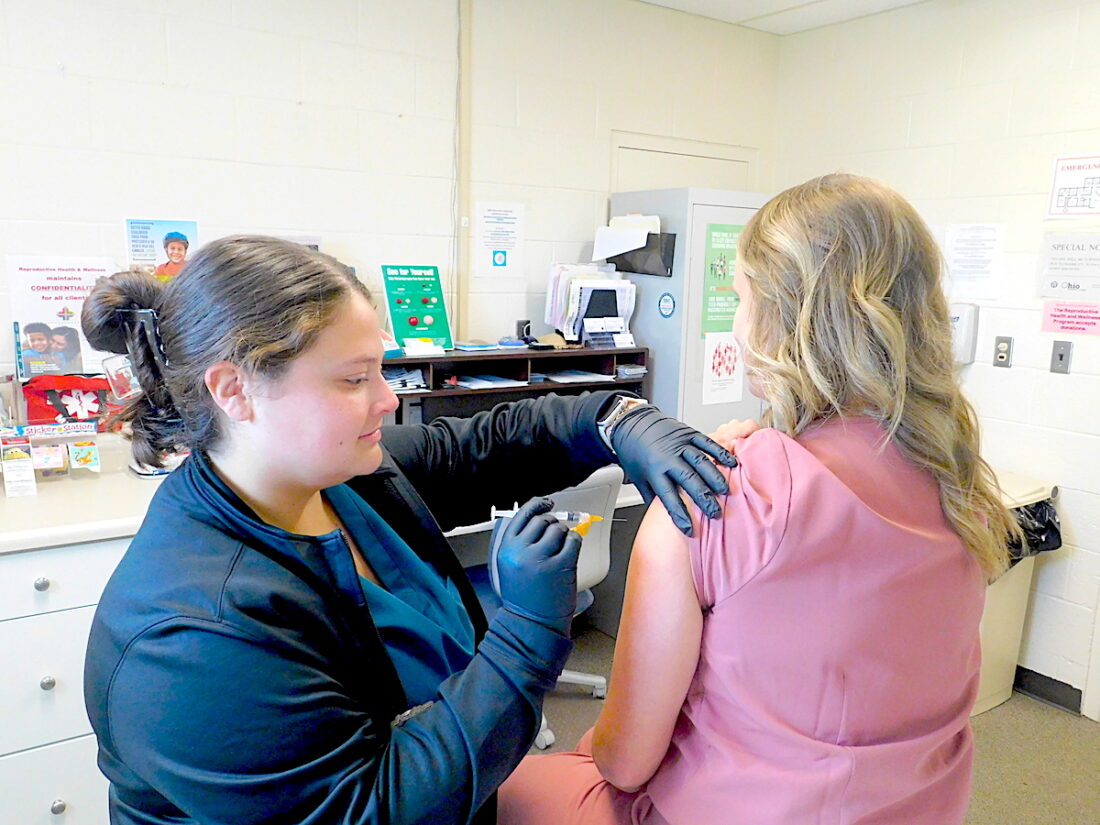It’s vaccination season for Belmont health department

T-L Photo/JOSIE BURKHART Belmont County Health Department Infectious Disease and Vaccine Nurse Jenna Cunningham demonstrates how to administer a vaccine to Director of Nursing Gabby Timko.
ST. CLAIRSVILLE — Health officials say it’s time for back-to-school vaccines with the start of the school year rapidly approaching.
Belmont County Health Department Vaccine Coordinator and Vaccine Nurse Anna Rife said all schools in Ohio require students to receive certain vaccines before attending school. She said school nurses do a good job of auditing vaccines to track which children need them. Those nurses will send out a letter to parents when their child is in need of a vaccination.
She also stressed the importance of receiving vaccines.
“Vaccines are important just for the communicable diseases that can be easily spread,” Rife said. “Without them, we would have more of the (illnesses) that are very harmful around the valley.”
Rife said the process of receiving vaccines is based on a person’s age, with the first dose of hepatitis B vaccine at birth or the first doctor’s appointment, with the second dose following at 1-2 months old and the third dose at the health department.
“Some people like to space out their vaccines for personal reasons. That’s completely fine,” she said. “But ideally, they should be completed every time they go to the doctor’s.”
If a patient’s doctor’s office does not administer the needed vaccines, it will recommend the patient receive them at the health department, she said.
After administering vaccines to patients, the health department faxes the updated vaccine record to the school or gives the patient an updated copy of their vaccine record to give to the school and lets them know when they are due for their next ones.
Rife noted she sees the most patients from preschool, kindergarten, seventh and 12th grades, when vaccines are required because of the students’ ages. Those students tend to visit during July and early August.
The health department also provides flu shots, and doctor’s offices that do vaccines will administer flu shots, too, she said.
Pharmacies and urgent care facilities typically do not offer childhood vaccines, she said, but they do administer booster shots, flu or COVID-19 shots to adolescents and adults.
Required vaccines for children include DTaP: diphtheria, tetanus and pertussis; hepatitis B; MMR: Measles, mumps and rubella; polio; varicella (chickenpox); Tdap: tetanus, diphtheria, pertussis and Meningococcal ACWY.
It is at the school’s discretion to decide if a student gets an exemption from vaccines if the parents wish to not vaccinate their children, but the health department will visit schools to promote vaccination of students, said Director of Nursing Gabby Timko.
She also said the health department will visit Shadyside Local Schools on Monday to administer vaccines to students who are behind on them.
According to the Ohio Department of Health, vaccines save lives, well child visits are essential, vaccination is very safe and effective and people can reduce the chance of spreading disease by staying up to date with them.
The ODH aims to reduce and eliminate vaccine-preventable diseases among Ohio’s children, adolescents and adults through its immunization program.
“Vaccines have protected us for years, like those preventing polio, measles and mumps,” said ODH Health Director Bruce Vanderhoff, MD, MBA, in a news release. “Before vaccines, diseases like these were common and caused great suffering and deaths every year. When enough people are vaccinated, it can greatly decrease the spread of dangerous diseases from child to child.”





